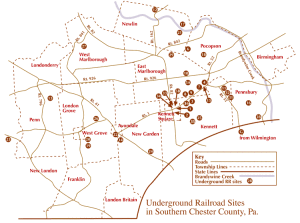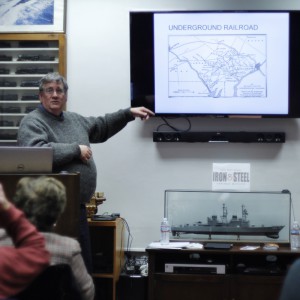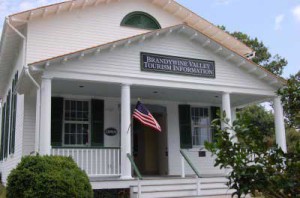Intrigue deepens at meeting with artist’s son, judge who championed its preservation
By Kathleen Brady Shea, Managing Editor, The Times
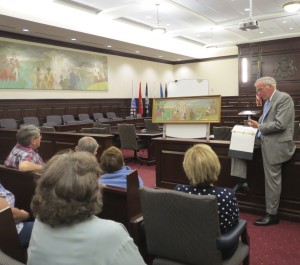
Chester County Court Judge Thomas G. Gavin discusses what little information is known about the 1956 mural by Edward Shenton. Behind him is the model painting that differs in numerous small ways from the finished product, now on the wall in Courtroom Two of the Chester County Justice Center.
The unsuspecting out-of-towner had no inkling that he could be flirting with jail time if he failed to answer the Chester County jurist’s questions.
For decades, Senior Judge Thomas G. Gavin had longed to unravel the mysteries associated with a celebrated mural commissioned for the courthouse in the mid-1950s. The judge had high expectations for a meeting on Friday with Ned Shenton, the son of the mural’s creator, Edward Shenton, who died in 1977.
Gavin joked that if the artist’s offspring couldn’t provide the revelations he sought, perhaps a few days behind bars would improve his memory. After all, who better than a descendant to explain the halo of sorts that surrounds the scales of justice or the numerous additions to the finished product – ranging from an Indian’s Mohawk to a woman’s apron – that don’t appear in the draft version submitted to a committee of art experts for approval?
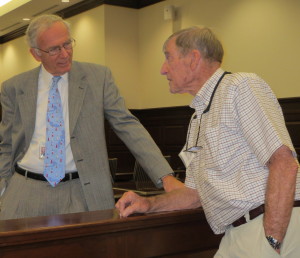
Chester County Court Senior Judge Thomas G. Gavin (left) chats with Ned Shenton, the son of the creator of a mural depicting county history that was painstakingly removed from a plaster wall of the historic courthouse before it was sold a couple of years ago.
Unfortunately for Gavin, Ned Shenton could not solve the conundrums, but he and a group of about a dozen associates he brought to Courtroom Two of the Justice Center provided lively commentary – dialogue that reinforced the commissioners’ wisdom in saving the mural when the historic courthouse was sold to a developer in September 2011.
Gavin explained that the oil painting first hung in the courtroom of Judge J. Paul MacElree, whose grandson, James P. MacElree 2nd, is the current president judge. Eventually, former Judge Lawrence E. Wood inherited the space, and when Wood retired in 2006, Gavin used his seniority to claim a view from the bench that included the 5- by 16-foot work – a compendium of Chester County history.
The mural depicts three groups of figures. A trio of Native Americans and a Quaker man showcase the bond between those groups. Three African Americans and a Quaker woman represent the Underground Railroad. And a gathering of diverse citizens in front of the courthouse, superimposed by oversized scales of justice bathed in white light, highlights the legal system. The background includes landmarks such as Lukens Steel, the Birmingham Meetinghouse, and Downingtown’s Log House.
The process of relocating the mural to the Justice Center was complicated by its placement on a deteriorating plaster wall, Gavin said. He said he was grateful the county commissioners hired Paul Gratz, a Doylestown conservator, to preserve Shenton’s legacy. Gratz became so invested in the painstaking process – which included facing the mural with Japanese tissue paper and coating it with a stabilizing solution before slowly detaching it from the wall with a scalpel – that he gave the county a substantial break on the price.
“It’s nice to see it properly rescued and restored,” Ned Shenton said. He said that he had little insider knowledge of his father’s work and that most of his heritage had been donated to museums. Ned Shenton said he had viewed the mural once in Judge Wood’s courtroom. He was unaware of the existence of the preliminary painting that had to pass muster from a committee that included John McCoy, N.C. Wyeth’s son-in-law; and Stewart Huston, a Lukens Steel scion.
In fact, Ned Shenton saw the model painting for the first time on Friday and met its owner, Peter Latta, a friend of MacElree’s who received it as a gift. Latta lives a short distance from the Shentons’ former homestead in East Bradford Township, which later named a road after the artist. “The painting ended up pretty close to home,” Latta said.
Some of Friday’s visitors were not, however. Ned Shenton and his wife, Ellie, traveled from Lexington, Mass., and their companions were members of a group called “Friends of Gladys Taber,” some of whom had come as far as Illinois and Vermont. Taber, an author and editor whose work included the “Diary of Domesticity” column for Ladies Home Journal, is also well-known for The Stillmeadow Road, a book illustrated by Edward Shenton.
Edward Shenton, who grew up in West Philadelphia, enrolled at the Pennsylvania Academy of Fine Arts after completing his World War I service in France. At the academy, he won awards that enabled him to study in Paris. He returned to France in 1952 to do a mosaic mural, his son said.
Noted for skills in writing as well as art, Edward Shenton first earned acclaim as the illustrator of The Yearling, a 1938 novel by Marjorie Kinnan Rawlings. A longtime association with Scribner’s editor Maxwell Perkins led to Shenton’s artwork for novels by William Faulkner, F. Scott Fitzgerald, Ernest Hemingway, and Thomas Wolfe.
Alta B. Hoffman, a Pocopson Township resident who heads the regional Taber group, said she enjoyed the opportunity to explore the connections between Taber, Shenton, and the other participants in Friday’s gathering. “History does stay alive, especially in Chester County,” she said.
Gavin agreed, and his quest to find contemporaneous writings about the project that might answer his lingering queries will continue. “I don’t know how we’re going to do it, but I’ll keep trying,” he said, wondering aloud if perhaps the Pennsylvania Academy of Fine Arts might hold some clues.
Absent the answers, county residents who end up in Gavin’s courtroom will likely get to hear the questions. The judge is known for filling the lulls that often accompany jury selection with conversation about the mural.

